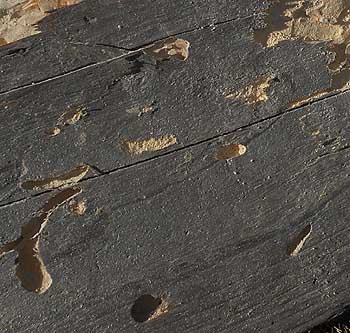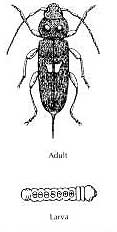House Longhorn Beetle - identify first - it could be Forest Longhorn - call us for help on 01626 872886 - speak to David or Angela
Where can I buy an HSE Registered Woodworm Treatment?
Call for help - 01626 872886
E Mail us for help - help@woodworm-expert-advice-forum.org.uk
Q. Why treat House Longhorn Beetle?
A. Because it's tunnels can severely and rapidly weaken floorboards and structural timbers, eventually leading to collapse. It is often found in roof timbers, so early diagnosis is essential.
Q. How can I tell that I have House Longhorn Beetle?
A. From the noise - you can actually hear them eating your wood - and from the large, oval holes. Don't wait until holes appear though - serious damage will have been done by then - if you hear scratching noises call us on 01626 872886 or a local expert.
Q. Can I save timber that is being eaten right now?
A. Yes, if you inject Property Repair System's Lignum Pro Gel into the active (listen, tap and drill) areas.
House Longhorn Beetle - Hylotrupes bajulus
In the UK House Longhorn Beetle used to be a Legally Notifiable Insect (no longer, as it is deemed to be mainly confined to Europe at present) and should not be treated without the prior involvement of a qualified Specialist. We can offer that Specialist assistance, having two qualified members of Staff, David and Angela.
House Longhorn Beetle causes potentially serious damage to softwood roofing timbers within a specific area of south-east England. Preliminary results of a new BRE survey indicate that most infestations are still within the area where protective treatment of roof timbers is mandatory under the Building Regulations. However, scattered infestations were still found in Great London, Kent, Sussex and Hampshire. Properties built during the 1920s and 1930s were most commonly reported as infested. There have been no reports of infestations in roof timbers treated in compliance with the Regulations.
House Longhorn Beetle requires more than surface treatment to eradicate an attack, because the insects have a long life cycle and rarely visit the surface of the timber. Treatment of 'normal' woodworm (Anobium punctatum) consists of surface treatment, by brush or spray, which breaks the egg laying cycle. Because their life cycle is short (up to 5 years) and their holes are considerably smaller than House Longhorn Beetle, it is considered sufficient to treat the surfaces of the timber only - for House Longhorn Beetle this will not be effective.
So, a House Longhorn Beetle treatment must incorporate two additional features - internal injection treatment and weekly inspection.
Firstly, remove all loose material by brush and vacuum and ensure that the timber will absorb moisture. No surface treatment will penetrate varnish or paint. Next, drill injection holes in the 'active' damaged areas - test for these using a hammer first, listening for hollowness and then drill test holes. If in doubt call us - we can recommend a local professional company, if necessary.
The holes need to be blown or vacuumed out and then injected with Lignum Pro Gel. The holes can be capped with dowels, wood filler or plastic plugs.
Then finish with a surface treatment of either Boron Gel, at 20% or Boron Borcol 10 liquid at the 10% concentration (BAE).
Check regularly for 'munching' sounds and re-inject active areas with Lignum Pro Gel.
HOUSE LONGHORN SUMMARY OF CHARACTERISTICS
Habitat in buildings - sapwood of most softwoods, particularly roofing timbers. Very occasionally found in softwood plywood.
Regulations - at present common only in area of England SW of London (mainly Surrey) where special Building Regulations exist to protect structural timber and prevent further spread. Small inactive infestations are common in buildings over 100 years old in London.
Special Features - with large infestations, larval feeding may be audible on warm days as scraping noise.
Emergence holes - few, large, oval, often ragged, 6 - 10 mm diameter.
Tunnels - oval, 6 - 10 mm diameter. Extensive and join up to cause almost complete disintegration of sapwood but leaving thin, intact, surface skin. Dust-filled tunnels may cause blisters or corrugations on surface of wood which may be observed with oblique lighting from torch.
Bore dust - cream-coloured, sausage-shaped pellets. Gritty when rubbed between fingers. Small chips and wood fibres may be present.
Likely misidentifications - Forest longhorn beetle, jewel beetle, wharf borer beetle, wood wasp, Tenebrionid beetle, Bostrychid powderpost beetle.
HOUSE LONGHORN BEETLE TREATMENTS
NOTE - House Longhorn requires injection of Lignum Pro Gel, as well as surface treatment (see below).
1. Surface Treatment
Ready to Use - 5 litres or 25 litres of Boracol 10 - already dissolved in water, for severe common furniture beetle attack and Dry Rot, both timber treatment and irrigation of masonry & sub-site soil.
Typical consumption rates - 2 timber floors, terraced house - 25 litres, or a roof, terraced house - 50 litres
Always follow the instructions on the product label, wear a dust mask when mixing and check with us before purchasing to ensure that you are buying the correct product.
2. ECOBOR GEL 20 - extra Surface Treatment
A extra heavy duty 20% active clear Gel ideal for end grain and bearing area treatment of beams and joists. Add to surface treatment with Boracol 10 in damp or heavily attacked areas. Also useful for medium to heavy active infestations of insect attack and treatment of new timbers for use in vulnerable areas (e.g. skirting boards).
3. Lignum Pro Gel - Deep Injected Treatment - for House Longhorn
An essential treatment for House Longhorn Beetle - Permethrin in an emulsion cream base. Has some odour and solvent. Do not use in buildings in proximity to fish or birds. Essential for deep seated active voracious House Longhorn Beetle, where the rate of destruction is too high and the moisture content of the wood is too low to spread the Boron based pastes fast enough to be effective.
Hole size - 6mm to 10 mm, oval. Damage is severe and very rapid.
References | Privacy Policy | Returns Policy | Home Page
Woodworm Expert Forum,
Property Repair Systems,
T: 01626 872886
E:help@woodworm-expert-advice-forum.org.uk
Other Property Repair Systems Sites:
www.boron.org.uk - how to use Boron based insecticides/fungicides to treat timber rots and insect attack
www.dampness-info.co.uk - how to treat penetrating dampness in walls and plaster
www.deck-treatment.co.uk - how to treat patio decks and yacht decks
www.dryrot.biz - how to kill Dry Rot in buildings
www.drywallandfloor.co.uk - membranes for lining damp walls, floors, basements and cellars
www.epoxy-info.co.uk - epoxy resins for repairing wood, concrete, brick and stone
www.fire-door-paint.co.uk - upgrade doors to 30 minutes fire resistance
www.joist-repair.co.uk - how to quickly repair joists and beams of any size
www.steel-fire-paint.co.uk - treat steel with Intumescent Paint to provide fire protection
www.timber.org.uk - systems of repair, with step by step methods
www.timber-repair.co.uk - how to repair timber beams
www.woodworm-info.co.uk - how to kill and prevent woodworm and death watch beetle

